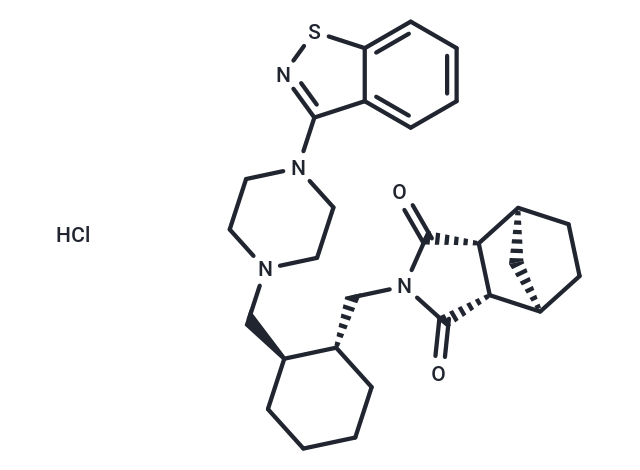Shopping Cart
- Remove All
 Your shopping cart is currently empty
Your shopping cart is currently empty
Lurasidone hydrochloride (Lurasidone HCl) is a thiazole derivative and atypical antipsychotic agent that functions as a dopamine D2 receptor antagonist; serotonin 5-HT2 receptor antagonist, serotonin 5-HT7 receptor antagonist, an antagonist of the adrenergic α2A and α2C receptors, as well as a partial serotonin 5-HT1A receptor agonist. It is used in the treatment of schizophrenia and bipolar disorder.

| Pack Size | Price | Availability | Quantity |
|---|---|---|---|
| 5 mg | $35 | In Stock | |
| 10 mg | $57 | In Stock | |
| 25 mg | $73 | In Stock | |
| 50 mg | $97 | In Stock | |
| 100 mg | $147 | In Stock | |
| 200 mg | $237 | In Stock | |
| 500 mg | $497 | In Stock |
| Description | Lurasidone hydrochloride (Lurasidone HCl) is a thiazole derivative and atypical antipsychotic agent that functions as a dopamine D2 receptor antagonist; serotonin 5-HT2 receptor antagonist, serotonin 5-HT7 receptor antagonist, an antagonist of the adrenergic α2A and α2C receptors, as well as a partial serotonin 5-HT1A receptor agonist. It is used in the treatment of schizophrenia and bipolar disorder. |
| Targets&IC50 | Noradrenaline α2C:10.8 nM, 5-HT2A:2.03 nM, 5-HT7:0.495 nM, 5-HT1A:6.75 nM, D2 receptor:1.68 nM |
| In vitro | Lurasidone antagonizes dopamine-stimulated [35S]GTPγS binding at human dopamine D2L receptor in a concentration-dependent manner with a KB value of 2.8 nM. Lurasidone antagonizes 5-HT-stimulated cAMP accumulation in the CHO/h5-HT7 cells with a KB value of 2.6 nM. Lurasidone partially stimulates [35S]GTPγS binding to the membrane preparation for human 5-HT1A receptors with a maximum effect of 33%. Lurasidone dose-dependently increases the ratio of DOPAC/dopamine in rat frontal cortex and striatum. [1] |
| In vivo | The inhibitory actions of Lurasidone on MAP-induced hyperactivity persists for more than 8 hours, and the ED50 values of the action at 1 hour, 2 hours, 4 hours, and 8 hours after the treatment are 2.3 mg/kg, 0.87 mg/kg, 1.6 mg/kg, and 5.0 mg/kg, respectively. Lurasidone (1 mg/kg–10 mg/kg) dose-dependently inhibits conditioned avoidance response in rats with ED50 of 6.3 mg/kg. Lurasidone dose-dependently inhibits TRY-induced forepaw clonic seizure and p-CAMP-induced hyperthermia in rats with ED50 of 5.6 mg/kg and 3.0 mg/kg, respectively. Lurasidone (0.3 mg/kg–30 mg/kg) dose-dependently and significantly increases the number of shocks received by rats in the Vogel's conflict test with MED of 10 mg/kg. Lurasidone (3 mg/kg, 2 weeks) significantly suppresses hyperactivity behavior in olfactory bulbectomy model rats. Lurasidone (700 mg/kg–1000 mg/kg) slightly prolongs the duration of loss of righting reflexes elicited by hexobarbital (anesthesia) in mice in a dose-dependent manner. [1] Lurasidone (30 mg/kg, p.o.) significantly and dose-dependently reverses the MK-801-induced impairment of the passive-avoidance response of rats. [2] Lurasidone (3 mg/kg p.o.) potently reverses MK-801-induced learning impairment in the Morris water maze test in rats. Lurasidone (3 mg/kg p.o.) potently reverses MK-801-induced reference memory impairment and moderately but not significantly attenuates MK-801-induced working memory impairment in the radial-arm maze test. [3] Lurasidone (10 mg/kg) treatment increases total BDNF mRNA levels in rat prefrontal cortex and, to less extent, in hippocampus. Lurasidone (10 mg/kg) significantly increases the levels of mature BDNF protein in rat prefrontal cortex, without affect the protein levels of the neurotrophin (both precursor and mature forms) in hippocampal extracts. [4] |
| Synonyms | SM-13496 Hydrochloride, Lurasidone HCl |
| Molecular Weight | 529.14 |
| Formula | C28H36N4O2S·HCl |
| Cas No. | 367514-88-3 |
| Smiles | Cl.O=C1[C@H]2[C@@H]3CC[C@@H](C3)[C@H]2C(=O)N1C[C@@H]1CCCC[C@H]1CN1CCN(CC1)c1nsc2ccccc12 |
| Relative Density. | no data available |
| Storage | Powder: -20°C for 3 years | In solvent: -80°C for 1 year | Shipping with blue ice/Shipping at ambient temperature. | ||||||||||||||||||||
| Solubility Information | DMSO: 5.29 mg/mL (10 mM), Sonication is recommended. | ||||||||||||||||||||
Solution Preparation Table | |||||||||||||||||||||
DMSO
| |||||||||||||||||||||

Copyright © 2015-2025 TargetMol Chemicals Inc. All Rights Reserved.